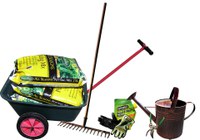Prairie Fare: Stretch Before Tackling Spring Yardwork
(Click an image below to view a high-resolution image that can be downloaded)
By Julie Garden-Robinson, Food and Nutrition Specialist
NDSU Extension
What was that snap, crackle and pop I heard?
I was not eating a popular breakfast cereal.
Those sounds were emanating from my joints. I was stretching at my computer while taking part in a virtual yoga activity.
My tired body felt better after our stretching activity on that Monday evening.
I should have stretched before we did a “weekend warrior” project in our backyard in the unseasonably warm weather the previous weekend.
Our 35-year-old maple tree lost its abundant leaves after the snow fell early last winter. The strong winds of Fargo, N.D., trapped leaves against the fence, under trees and all around our house. Branches needed trimming and hauling.
I was doing a lot of bending, lifting and carrying as we raked and bagged leaves. My muscles were rebelling at the physical labor.
I took a break to examine my raised garden beds. They were full of leaves, too, but the chives were sprouting.
I wandered to the nearby perennial beds and noted lilies and hostas were peeking through the soil and a thick layer of maple leaves.
Soon the soil would be warm enough for me to plant flowers and vegetables.
We hauled many (many) bags of leaves to the city’s recycling area. I felt good about being out in the fresh air and doing something with immediately gratifying results.
Some researchers have linked a decreased risk for diabetes and osteoporosis to the physical activity accumulated during gardening and other yard work.
Outdoor yardwork burns abundant calories. Raking leaves burns about 350 to 450 calories per hour, depending on your size. Planting flowers burns about 200 to 400 calories per hour.
Be sure to stretch first.
Here is some information gleaned from our “Stretching Toward Better Health” NDSU Extension publication (available at https://www.ag.ndsu.edu/publications/health-fitness/stretching-toward-better-health).
The online publication with how-to photos features many stretches that can be done while sitting in a chair, plus other “floor exercises.” It was written with a faculty member with expertise in exercise science.
To stretch a muscle properly, you should try to lengthen the muscle to a point where you just feel the muscle stretching. Stretching should not hurt. The statement “no pain, no gain” has no place in a stretching program.
Hold the stretch for six to 10 seconds, lengthening the muscle if it relaxes in that period of time. Relax, then repeat the exercise.
While you are stretching, you must remember to continue to breathe. Holding your breath during a stretch may increase your blood pressure above safe levels. If you continue to breathe as you stretch, your blood pressure should remain within normal limits.
I think a little strength training might be in order prior to tackling additional summer yardwork, too. My daughter gingerly lifted a 40-pound bird bath into place. She needs to be my trainer before we move soil and landscaping rocks in place.
According to the National Institute on Aging, these are some tips to start a training program:
- Check with your health-care provider before beginning a strength training program, especially if you have back or hip issues.
- Join a class to get some training, employ a personal trainer or at least read articles and/or watch DVDs or online demonstrations.
- Start with light weights and gradually increase the amount of weight. You can use gym equipment or weights in your house, or even 1- or 2-pound cans of food.
Although our spring 2021 “Field to Fork” gardening webinars have drawn to a close, you can view the archived versions. See https://www.ag.ndsu.edu/fieldtofork and click on “All Archived Webinars” to listen to the recorded versions.
This year’s lineup included many NDSU Extension specialists and guests from the North Central Region who discussed topics such as shopping in a garden center, choosing the best vegetable varieties and even tapping trees for maple syrup.
Maybe my tall maple tree can yield some syrup besides an abundance of leaves for us to rake.
Chives are quite prolific in early spring, so here is a way to enjoy fresh chives at home.
Fresh Chive Dip
1 c. reduced-fat sour cream (or plain Greek yogurt)
1 tsp. crushed garlic
2 tsp. French onion soup powder
2 Tbsp. fresh chives, chopped
Place the sour cream in a small bowl and stir in the garlic. Rinse and pat dry fresh chives on a paper towel, then finely chop the chives and add to the sour cream mixture. Add the onion soup and mix well. Refrigerate if not serving immediately. Enjoy with crackers or carrot sticks.
Makes 16 (1-Tbsp.) servings. Each serving has 30 calories, 2 grams (g) fat, 1 g protein, 1 g carbohydrate, 0 g fiber and 60 milligrams sodium.
(Julie Garden-Robinson, Ph.D., R.D., L.R.D., is a North Dakota State University Extension food and nutrition specialist and professor in the Department of Health, Nutrition and Exercise Sciences. Follow her on Twitter @jgardenrobinson)
NDSU Agriculture Communication - April 15, 2021
Source: Julie Garden-Robinson, 701-231-7187, julie.garden-robinson@ndsu.edu
Editor: Ellen Crawford, 701-231-5391, ellen.crawford@ndsu.edu




